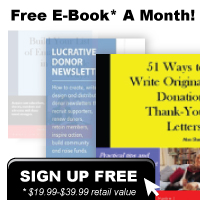The electronic world offers tremendous opportunity, but let’s not forget about the basics . . .
There is no doubt – email, web sites, social media and all the other tools of the electronic world have great potential.
And any nonprofit organization that ignores them would be making a huge mistake. Money raised through these means continues to grow every year and will likely grow significantly over the next decade.
But the lions share of donations to nonprofits has been and will continue to be raised by the tried and proven workhorses of fundraising –the telephone and direct mail. They are more reliable, more predictable and provide a better return on investment than other methods. This may eventually change and the phone and mail may give way to more effective approaches but for now and the foreseeable future, if you’re not using both mail and phone, you are missing out.
The most powerful way to convince someone to donate is to meet with them face-to-face. And some organizations do run door-to-door campaigns. But when you compare the number of people you can reach door-to-door in a week to the number you can reach by telephone, the phone is a hands down winner. If you want to speak with thousands of people in a short period of time, the telephone is the only way to do it. It is the most effective way to raise a large amount of donations in the shortest possible time.



